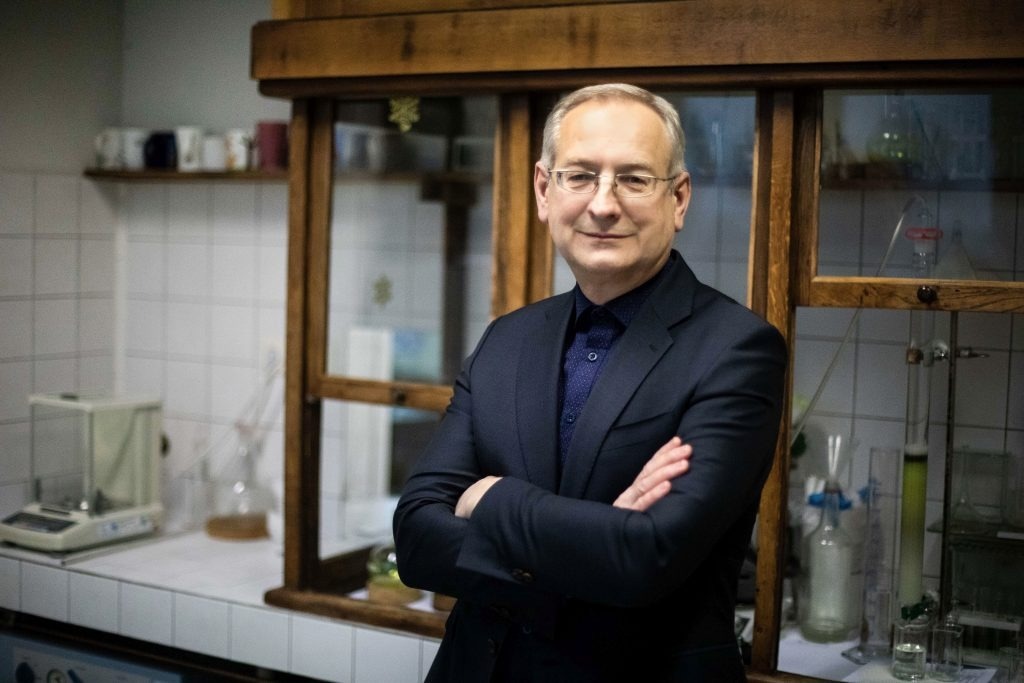Reviewed by Lexie CornerMar 20 2024
Lithuanian chemists at Kaunas University of Technology (KTU) created a novel substance for perovskite solar cells. It may be employed as a hole-carrying layer in standard and inverted architectural solar cells after polymerization; in both scenarios, the solar elements produced have higher power conversion efficiency and stable operation.
 Professor Vytautas Getautis, Head of the Synthesis of Organic Semiconductors research group at KTU. Image Credit: Kaunas University of Technology (KTU)
Professor Vytautas Getautis, Head of the Synthesis of Organic Semiconductors research group at KTU. Image Credit: Kaunas University of Technology (KTU)
The photovoltaic community has shown great interest in perovskite solar cells (PSCs) because of their rapidly increasing power conversion. PSCs can be produced at a low cost using a large supply of readily available raw ingredients, allowing for further scaling up.
These features point to PSCs being a viable mainstream solar technology in the future. To meet market demands, perovskite solar devices' long-term stability under realistic operating settings must be improved.
The chemists at KTU in Lithuania have synthesized a novel 9,9′-spirobifluorene derivative with thermally cross-linkable vinyl groups, which may aid in resolving some of the aforementioned issues.
A smooth, solvent-resistant three-dimensional (3D) polymeric network is created after thermal cross-linking, and this network is utilized as a hole-transporting component in perovskite solar cells.
The copolymerization takes place at a relatively low temperature (103 °C), which makes the technology safe for use in the casting of a layer on perovskite, which is not resistant to temperatures above 140 °C. Another very important aspect is that the polymerization process is incredibly fast, apparently due to the specific spatial configuration of the monomer.
Šarunė Daškevičiūtė-Gegužienė, Study Co-Author, Faculty of Chemical Technology, Kaunas University of Technology
Comparing the resultant devices to traditional hole transportation materials (PTAA or Spiro-OMeTAD), the former showed superior energy conversion efficiency and the latter, vitally, stability.
High Commercialization Possibilities, Patent Pending
PSCs are stacked, next-generation solar cells that come in two different architectonic configurations: regular (n-i-p) and inverted (p-i-n). In the latter case, the materials for conveying holes are deposited behind the layer of perovskite absorber.
The KTU laboratories synthesized the monomer, which readily yields 3D polymers resistant to solvent and can be employed in both types of perovskite solar cells.
Polymer synthesis is carried out by heating the monomer layers for as little as 15 min, yielding spatially structured insoluble polymer matrices.
Vytautas Getautis, Professor and Lead Researcher, Synthesis of Organic Semiconductors Research Group, Kaunas University of Technology
The well-researched p-type semiconductor Spiro-OMeTAD has produced the best results for conventional structure (n-i-p) perovskite solar cells. The latter, however, has not been employed in inverted structure (p-i-n) devices because of its solubility.
The polar solvents used in the perovskite layer's molding dissolve the hole transporting layer below.
Synthesis of the 9,9′-spirobifluorene derivatives at KTU laboratories produces a cross-linked organic solvent-resistant polymer layer. In the meantime, when the perovskite layer is produced on the (n-i-p)-structured devices, a copolymer of the 9,9′-spirobifluorene derivatives with a dithiol (e.g., 4,4′-thiobisbenzenethiol) protects it against undesired environmental impacts like dampness.
As a result of the unique synthesized material's strong commercialization potential, the EU, USA, and Japanese patent offices received the application for a patent.
Cooperation Between Lithuanian and Japanese Scientists
The researchers underscore that the results achieved were the result of successful collaboration between scientists from Lithuania and Japan.
For several years now, our research group has been collaborating with that of Professor Atsushi Wakamiya at Kyoto University, which is well-known among perovskite solar cell researchers not only in Japan but also worldwide. It was they who designed and characterized perovskite solar cells using our synthesized p-type organic semiconductors.
Vytautas Getautis, Professor and Lead Researcher, Synthesis of Organic Semiconductors Research Group, Kaunas University of Technology
Professor Vygintas Jankauskas of Vilnius University, a longtime collaborator of KTU chemists, has been studying the electrical properties of these semiconductors.
Numerous advancements in the field of solar technology have been made possible by the KTU research group led by Professor Getautis. Among them are synthesized compounds capable of self-assembling into a molecule-thin layer, functioning as a hole-transporting material. This material has been instrumental in fabricating silicone-perovskite tandem solar cells, setting new records in efficiency.
Professor Getautis asserts that solar energy is the least utilized renewable resource with the greatest potential. However, this sector is expanding rapidly due to the recent studies. It is projected that around 50 % of the electricity utilized globally by 2050 will originate from solar power.
Vytautas Getautis concluded, “Solar energy is entirely green–it is pollution-free, and the installed solar farms do not require much maintenance. Keeping in mind current events, and the energy crisis, more and more people are interested in installing solar power plants in their homes or owing a share of a solar farm. It is a future of energy.”
Journal Reference:
Geguziene, D. S., et al. (2023) In Situ Thermal Cross-Linking of 9,9′-Spirobifluorene-Based Hole-Transporting Layer for Perovskite Solar Cells. ACS Applied Materials & Interfaces. doi.org/10.1021/acsami.3c13950